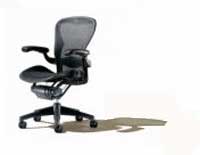Note: This site is moving to KnowledgeJump.com. Please reset your bookmark.
The Design of Herman-Miller's Aeron Chair
Good design is a Renaissance attitude that combines technology, cognitive science, human need and beauty to produce something. - Paola Antonelli, Museum of Modern Art

 Designers Don Chadwick and Bill Stumpf, of Herman Miller, a global provider of office furniture, set out to design a new kind of chair.
Designers Don Chadwick and Bill Stumpf, of Herman Miller, a global provider of office furniture, set out to design a new kind of chair.
Most designers start with a framework, but they decided that if they were truly going to come up with a radically new design, they would have to start with a clean slate about its form, however, the function had to be:
- Ergonomic - healthy for anyone who sits for long periods
- Functional - simple to adjust
- Anthropometrical (anthropometry) - more than just accommodate different sizes of people, it had to fit them
- Environmentally friendly - use no more resources than needed and be recyclable

Form follows Function
Form ever follows function -- said architect Louis Henri Sullivan in 1896. Sullivan's quote implies not that there is a greater importance of function over form, but rather that the two are intricately linked together. Yet, most designers fail to draw from Sullivan's words. For example, since the human body has no straight lines, the Aeron chair became curvy, without a single-straight line, which fits the function of ergonomic. This curvilinear gives it both a visual and tactile metaphor of the human form, which in turn, gives its unique design.
Its thin transparent layer (pellicle) that stretches over its frame was equally a great design strategy in that it allows the human body to breath, in addition to stretching just enough to give it a good fit, but does not pinch, hence it is functional. While at the same time, having a great form in that its transparency symbolizes the way permeable membranes permit the flow of air or light or moisture (such as lace or screens). This transparency is part of a major design movement that makes the technology less opaque, in addition to communicating the object's inner workings.
Since it does not use a lot of foam, padding, and coverings, in addition to being constructed of largely of recycled materials, makes it quite environmentally friendly.
Style Versus Design
Many young web designers view their craft the way I used to view pop culture. It's cool or it's crap. They mistake Style for Design, when the two things are not the same at all. Design communicates on every level. It tells you where you are, cues you to what you can do, and facilitates the doing. Style is tautological; it communicates stylishness. In visual terms, style is an aspect of design; in commercial terms, style can communicate brand attributes." - Jeffrey Zeldman
While Zeldman's quote is about web designers, his statement speaks to almost all designers, to include instructional designers. For example, strictly following the ISD model only means that your learning package is styled in the manner of ISD - when you look at it you say, "Aha, this designer was schooled in ISD." Thus, it simply communicates a style that does not necessarily transfer over to good design. Whereas great design goes much deeper -- it tells the learner at what point in the learning curve she is, cues her as to what she needs to do to become proficient, and then facilitates her learning.
Next Step
Return to Completing the Zen in Performance Management
